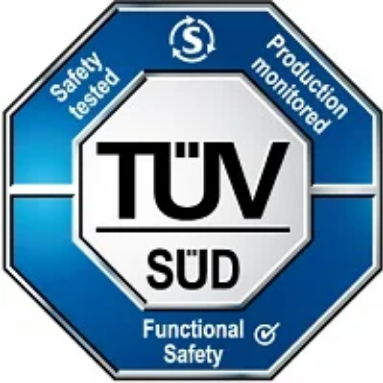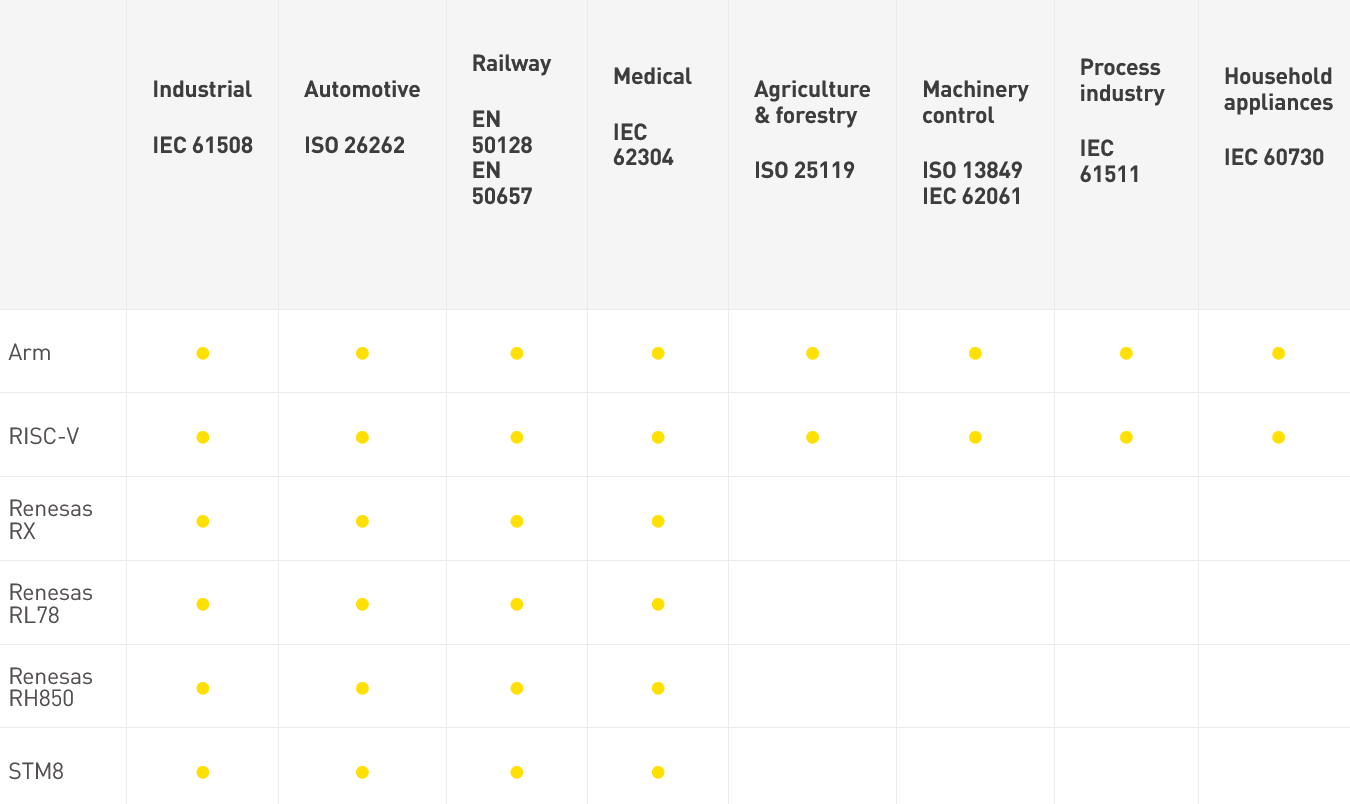Functional Safety
Building applications with ensured functional safety can be both challenging and time consuming. IAR Systems are here to guide you!
IAR Systems tools are certified according to ten different standards for functional safety. Combined with their dedicated team and long-term safety support services, they are ready to help you succeed with your next safety-critical application.
To be able to build applications with ensured functional safety, you often need to provide extensive documentation for selecting a particular toolchain and to prove that you are compliant with specific requirements in your sector.
By choosing a pre-certified solution, you will save both time and cost which enables you to focus more on your code and the features of the application.
IAR Systems Safety-Certified Solution
Does your Project Require Functional Safety?
What IAR Systems can offer you:
- Development tools certified by TÜV SÜD
- Long-term technical support through a special functional safety agreement
- Safety certificate renewal as long as agreement is active
- Coverage of 10 safety standards
- Full flexibility with wide tools support across architectures
IAR Systems are here to help you, all the way from project start to end of product life cycle.
Certified by TÜV SÜD – What does it mean?
The functional safety editions of IAR Systems tools are certified by the safety-accredited certification body, TÜV SÜD, as qualified for development of safety-related applications according to the mentioned standards.
By selecting IAR Embedded Workbench, functional safety edition, as a development tool, you do not have to evaluate the tool development process yourself and also not demonstrate language standards compliance by your own testing. This has already been taken care of by TÜV SÜD. The same applies to the functional safety editions of IAR Build Tools.
The certification was proceeded by a thorough assessment of how IAR Systems develop, test and support its software.

Broad Coverage of Standards
To suit different application needs, we provide functional safety tool editions for a number of different architectures.

These Standards are Covered:
IEC 61508
IEC 61508 is the international umbrella standard for functional safety. The standard, and standards derived from it, is used within all kinds of industries with requirements on reliability and safety, for example process industries, the oil and gas industry, nuclear power plants, machinery, and railway control systems.
ISO 26262
ISO 26262 is used for automotive safety-related systems.
EN 50128 and EN 50657
EN 50128 and EN 50657 are European standards for safety related software in railway applications. The standards are derived from IEC 61508.
IEC 62304
The international standard IEC 62304 is a standard which specifies life cycle requirements for the development of medical software and software within medical devices.
ISO 25119
Safety requirements for tractors and machinery for agriculture and forestry. The standard is a sector-specific implementation of IEC 61508. According to ISO 25119-3 “tools and translators which are proven in use shall be applied, in order to avoid any difficulties due to translator failures which can arise during development”.
IEC 62061
Sector-specific (safety-related electrical control systems on machinery) standard derived from IEC 61508. It specifies the requirements for the design, integration, and validation of Safety Related Electrical Control Systems for machinery applications.
EN ISO 13849-1
A safety standard for machines (like IEC 62061) and focuses on electrical, electro-mechanical and mechanical (hydraulics) parts. It provides safety requirements for the principal design and integration of safety-related parts of control systems (SRP/CS), including the design of software.
IEC 61511-1
A sector-specific standard (process industry) derived from IEC 61508. The software requirements of this standard are limited to application software developed using FPL (fixed program language) or LVL (limited variability language).
IEC 60730-1
This standard applies to automatic electrical controls for use in, on, or in association with equipment for household and similar use. Requirements related to software are extracted from IEC 61508-3 and adapted to the needs of this standard.
Support and maintenance as long as you need it
Thanks to special Functional Safety Support and Update Agreement (SUA).
The functional safety edition comes with a special Functional Safety Support and Update Agreement (SUA), that gives you guaranteed support for the sold version for the longevity of the agreement.
In addition, the tools are delivered in frozen versions, and are only updated through validated service packs.
To further simplify the validation of your application, each version includes a Functional Safety certificate and a Safety report from TÜV SÜD. Additionally, the included Safety Guide has practical tips for helping you certify your application, from detailing the use of the tools in a functional safety context to libraries and C/C++ programming language recommendations.
For each frozen version, the functional safety certificates get renewed as long as the support and updates agreement with you is active.
IAR Systems Functional Safety Products
Development Toolchain
- Certified Toolchain
- IAR Embedded Workbench for ARM, Functional Safety
- Certified by TÜV SÜD
- Simplified validation
- Support for entire product lifecycle
- Integrated code analysis add-ons
- IAR Embedded Workbench for ARM, Functional Safety
- Certified Toolchain
- IAR Embedded Workbench for RISC-V, Functional Safety
- Certified by TÜV SÜD
- Simplified validation
- Support for entire product lifecycle
- Integrated static analysis add-on
- IAR Embedded Workbench for RISC-V, Functional Safety
- Certified Toolchain
- IAR Embedded Workbench for Renesas RH850, Functional Safety
- Certified by TÜV SÜD
- Simplified validation
- Support for entire product lifecycle
- Integrated static analysis add-on
- IAR Embedded Workbench for Renesas RH850, Functional Safety
- Certified Toolchain
- IAR Embedded Workbench for STM8, Functional Safety
- Certified by TÜV SÜD
- Simplified validation
- Support for entire product lifecycle
- Integrated static analysis add-on
- IAR Embedded Workbench for STM8, Functional Safety
- Certified Toolchain
- IAR Embedded Workbench for Renesas RL78, Functional Safety
- Certified by TÜV SÜD
- Simplified validation
- Support for entire product lifecycle
- Integrated static analysis add-on
- IAR Embedded Workbench for Renesas RL78, Functional Safety
- Certified Toolchain
- IAR Embedded Workbench for Renesas RX, Functional Safety
- Certified Toolchain
- Simplified validation
- Support for entire product lifecycle
- Integrated code analysis add-ons
- IAR Embedded Workbench for Renesas RX, Functional Safety
Build Tools for Automated Workflows
- Certified Build Tools
- IAR Build Tools for ARM, Functional Safety
- Certified by TÜV SÜD
- Flexible and high performance
- Support for entire product lifecycle
- Modern workflows with cross-platform benefit
- IAR Build Tools for ARM, Functional Safety
- Certified Build Tools
- IAR Build Tools for Linux for RISC-V, Functional Safety
- Certified by TÜV SÜD
- Flexible and high performance
- Support for entire product lifecycle
- Modern, scalable workflows
- IAR Build Tools for Linux for RISC-V, Functional Safety
- Certified Build Tools
- IAR Build Tools for Linux for Renesas RH850, Functional Safety
- Certified by TÜV SÜD
- Flexible and high performance
- Support for entire product lifecycle
- Modern, scalable workflows
- IAR Build Tools for Linux for Renesas RH850, Functional Safety
Integrated Code Analysis
Code Analysis and Functional Safety – A Great Match!
Many industry standards require the use of code analysis tools. In this article, you will learn how you can use IAR Systems code analysis tools when developing safety-certified applications.
Code Analysis for Functional Safety
- Code Analysis Add-On
- C-STAT
- Static analysis of C and C++ code
- Check code compliance with standards
- Flexible, detailed and fast
- Integrated with IAR Embedded Workbench
- C-STAT
- Code Analysis Add-On
- C-RUN
- Find actual errors at runtime
- Intuitive and easy-to-use
- Integrated with IAR Embedded Workbench
- Stand-alone mode
- C-RUN
